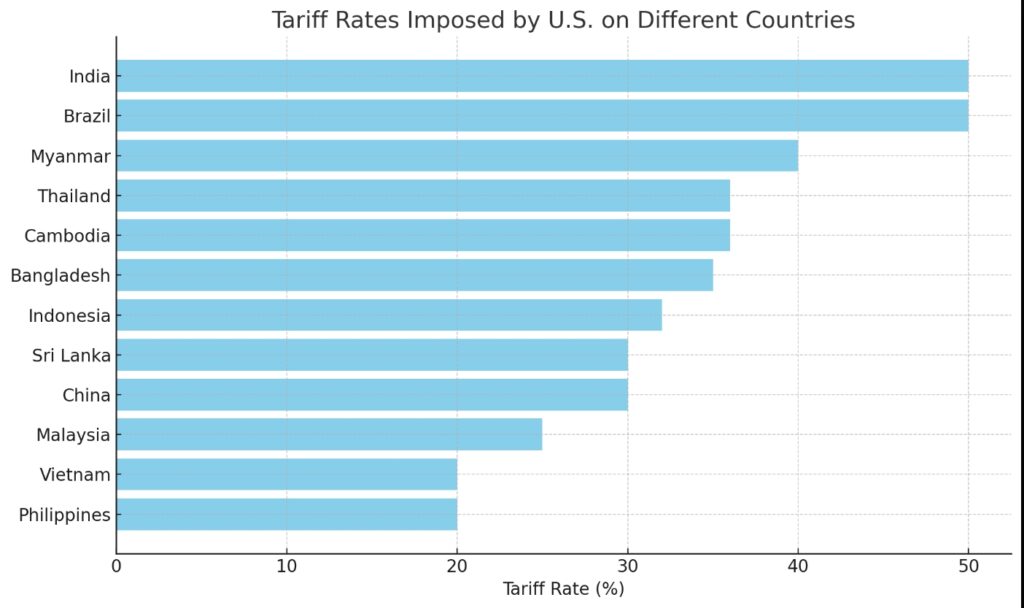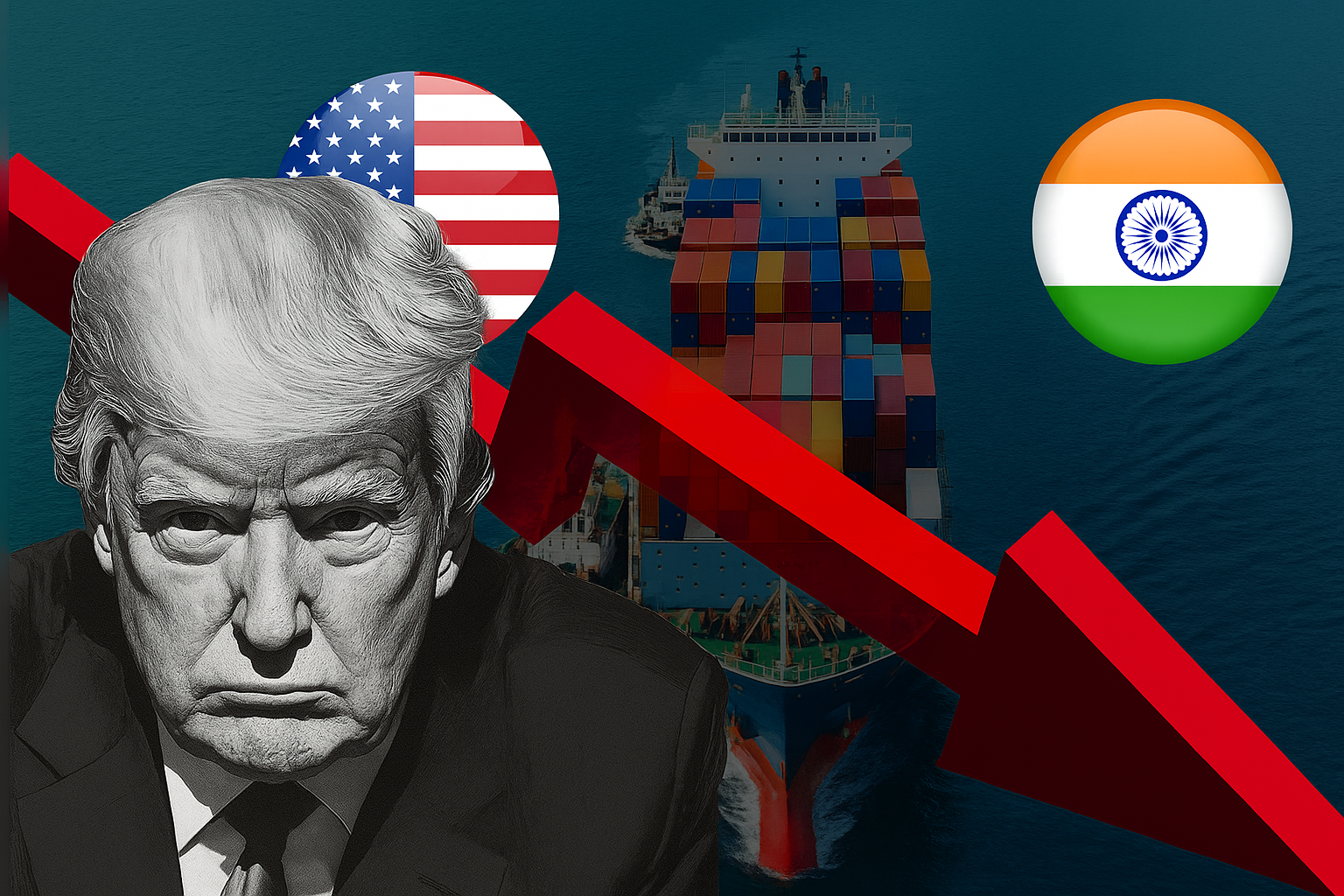Synopsis: US President Trump tariffs India with imposes additional 25% tariffs due to purchases of Russian crude oil, which makes a total of 50% tariffs which is posing a negative impact on the overall Indian economy. As per geopolitical think tanks, which seems to be a tactic amid ongoing trade deal negotiations
Table of Contents
Trump tariffs India with an additional 25% on India for purchasing crude oil from Russia, hampering the Indian economy. If it is implemented with the rate of persistence, with a moving pressure tactic.
Trump signed an executive order imposing 25% additional tariffs on Indian exports to the USA because of the purchase of Russian crude oil. But Trump did not voles additional tariffs on China, which is the largest importer of Russian crude oil. These heavy duties are mainly applied to India`s textile, marine, and leather export sectors.
Trump issued the executive order titled “Addressing Threats to the Government of the Russian Federation,” adding layers to the preexisting 25% tariff. Adding the current total of 50% tariff on the Indian goods in the US market.
Statement of Trump: “I find that the government of India is currently directly and or indirectly importing Russian Federation oil. Accordingly, and as consistent with applicable law, articles of India imported into the customs territory of the US shall be subjected to an additional duty of 25 percent.”
Where India stands on the Trump tariffs table:

The revised tariff table places India and Brazil at a significant disadvantage, both facing the highest rate of 50% in the U.S. market. They are followed by Myanmar at 40%, Thailand and Cambodia at 36% each, Bangladesh at 35%, and Indonesia at 32%. China and Sri Lanka are subject to a 30% tariff, while Malaysia stands at 25%. Vietnam and the Philippines face the lowest rate, at 20% each. (According to the source)
How Trump tariffs India, with 50% impact on the economy?
The major chunk of the industries that will face a heavy dent includes textiles/clothing, gems and jewelry, leather and footwear, animal products, chemicals, and electrical and mechanical machinery.
The pharmaceutical items, energy resources, oil, refined fuel, natural gas, coal, and electrical items, like computers, tablets, smartphones, solid state drives, etc., are totally exempted from the list.
#TrumpTariffs | 🚨 Trump Slaps 50% Tariffs on India.
— Moneycontrol (@moneycontrolcom) August 6, 2025
The country is now among the most heavily tariffed Nations by USA #Tariffs #India #USA #DonaldTrump pic.twitter.com/jPktCjYkki
Trump tariffs India: Impacts on Indian exports to the U.S.
According to the DG of Federation of Indian export organizations (FIEO), Ajay Sahai, “It’s extremely shocking, it will impact India’s 55% of the export to the US.
According to the trade report, India enjoys trade surpluses when it sells goods to the US market and the total trade reached $131.8 billion in 2024-2025, in which $86.5 billion were the exports and only $5.3 billion were imports from the USA.
Trump tariffs India: Is Trump building external Pressure?
Experts believed this decision by Trump was a strategic move to pressure India`s position regarding US demands in the proposed India-US trade deal.
Trump designed this pressure indirectly to stop the long-lasting Russia-Ukraine war. By threatening countries that import a high amount of crude oil from Russia, which indirectly or directly funds the Russian Federation, to keep the momentum in the war.
🚨 BIG STATEMENT 🚨
— Megh Updates 🚨™ (@MeghUpdates) August 10, 2025
RM Rajnath Singh: “Some forces are TRYING to make Indian products COSTLIER to SLOW growth.”
“But NO power in the world can STOP India from becoming a BIG POWER in the world.”
— Indirect JIBE at US...? pic.twitter.com/1Og3LPsU4x
Trump tariffs India: How India Reacted to 50% tariffs by Trump?
India reacted strongly to the West (US), calling such moves unfortunate. The Ministry of External Affairs issues a statement saying that ” India has previously clarified its stance on these matters, emphasizing that oil procurement decisions are driven by the market conditions and are essential for securing the needs of India`s 1.4 billion population.”
Statement by Official Spokesperson⬇️
— Randhir Jaiswal (@MEAIndia) August 6, 2025
🔗 https://t.co/BNwLm9YmJc pic.twitter.com/DsvRvhd61D
| Aspect | Details |
|---|---|
| What | 50% total tariff on Indian goods (25% new + 25% existing) |
| Why | Punitive response to India’s continued imports of Russian oil |
| When | Effective 21 days post-August 6, 2025 (targeting August 27, 2025) |
| Impact | Major export sectors threatened; potential GDP slowdown |
| India’s Options | Negotiations, reduced Russian oil imports, BRICS alliances, domestic reforms, tariff retaliation |
| U.S. Dynamics | Political and legal challenges to executive tariff authority |
Conclusion
The imposition of a 50% tariff on Indian goods by the Trump administration marks a significant shift in US-India trade dynamics. While framed as a response to India’s continued purchase of Russian crude oil, the move appears to serve a dual purpose—applying economic pressure during trade negotiations and signaling geopolitical disapproval.
With this critical Indian export sector now under strain, the economic fallout could be substantial if the tariffs persist. India’s firm response reflects its prioritization of energy security and sovereign decision-making.
As the 21-day negotiation window unfolds, the global community watches closely, anticipating whether this standoff will escalate or pave the way for a new trade understanding between the two nations.
The GeoLens – India || Defence || Global Affairs

Pratik Kondawale
Strategist | Indian Defence & Global Affairs
Founder of GeoLens.in, Pratik writes in-depth analysis on India’s defence strategy, military tech, and global power shifts delivering sharp insights through an Indian lens.

1 thought on “Trump Tariffs India: U.S. Imposes 50% Tariff, gives 21 Days for Negotiation—What It Means for Indian Economy”